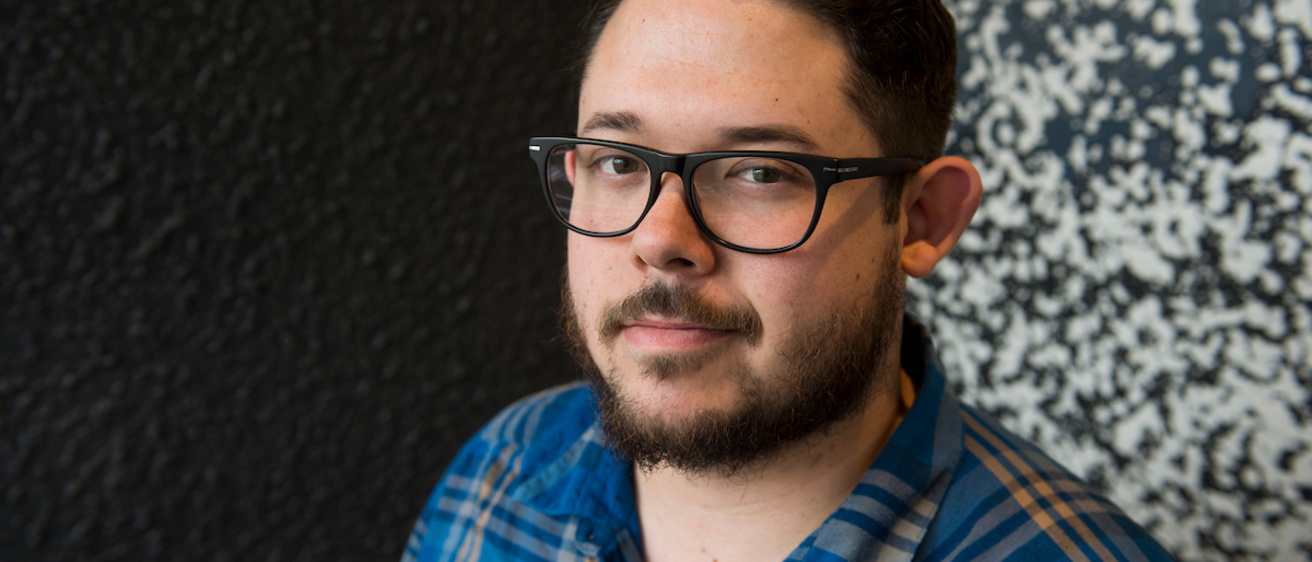Look at Robby Scott’s art and you see a dark mass painted on canvas or small, grotesque sculptures crafted from black resin.
Robby Scott’s MFA exhibition, “GRAVITAS,” will be on display in Gallery E260 of the Visual Arts Building April 3–7. A closing reception will take place from 6 to 8 p.m. Friday, April 7, in the gallery.
The work is a window into what he sees when he looks back on his own childhood. But as nightmarish as his art is, the fact it exists shows that he survived what he calls the hell that inspired it and has forged a stable enough life to even consider creating art.
“I’m the black sheep of the family, but in a positive way,” says Scott, a third-year MFA student in the University of Iowa School of Art and Art History. “I took a very different path in my life than my family.”
He was born near Oakland, California, into a family of people he says had quick tempers, abusive tendencies, mental illness, and unfortunate affections for drugs and alcohol. He was occasionally raised by one or both parents, other times by other family members, spending substantial parts of his childhood bouncing across California, Florida, and Tennessee. The only constants he recalls were chaos, abuse, and poverty.
He attended 12 different schools before he got to high school and says he was picked on at every one. The kid with big ears who lived in the wrong neighborhood, who wore stained shirts and shoes with holes in them. He stuck out in all the wrong ways. He rarely made friends, attracting the attention only of bullies.
When he was a freshman in high school, his mother moved with him to Iowa, hoping the isolation of small-town Postville would insulate them from the family’s demons on the West Coast. The move was a boon for Scott, who finally found stability, safety, and positive role models in school. He started participating in sports and other activities. He made friends, and found teachers and coaches who took him under their wings. They even helped him endure the frustration of filling out financial aid forms when he applied for admission to nearby Luther College in Decorah.
“After I moved to Iowa, my grades improved, people took an interest in me and cared about me,” he says. “For the first time, I didn’t fall through the cracks.”
One of the places his new mentors guided him was art. He had always dabbled in art for as long as he can remember, drawing figures and simple renderings whenever he had the chance.
“It was cheap and it was something I was able to do, something I seemed good at, and I loved it,” Scott says. “People told me I was good at it, so it was a form of positive feedback, a way to get good attention from other people, which I didn’t get from my family.”
His approach to art changed when he was an undergraduate at Luther and discovered Agnes Martin, a Canadian abstract artist whose reductive minimalism Scott admired.
“It’s light and airy and it’s something you experience,” he says. “You feel it, you don’t just look at it.”
He realized art could be about more than nice drawings, that it could communicate meaning. Like Martin’s minimalist work, Scott’s paintings rely on few colors and abstract forms. But where Martin’s work is light and airy, Scott’s is dark and heavy, the paint piled on thick like nightmares from his past.
Martin’s work also was influenced by the schizophrenia she suffered throughout her life, something else that Scott identified with. He eventually was diagnosed with PTSD, depression, and anxiety from his childhood experiences, and realized his art was a way to deal with the storms in his mind.
“My bodies of work never made sense when I looked at them, but after therapy I put it all together and saw it’s about my life, the need to escape my family, or admiring the people I look up to,” he says. “It helped me understand the people in my life and why they made the choices they made that hurt other people.”
For instance, that oil paint piled so thick on the canvas in his paintings—“nasty goo,” he calls it—resembles the residue found in bongs and drug paraphernalia. Or his sculptures, no more than a few inches high, are easily portable, something that can be quickly grabbed when a family member tells a child to hurry up, we’re hitting the road to stay one step ahead of the police.
“It put my life in perspective,” he says. “I can accept my childhood for what it is and not be ashamed, and I can understand it’s part of my experience.”
As might be expected, the dominant color of his work is black.
“I deal with my past that way, and my trauma and how the abuse from others has shaped me,” he says. “I want those translated in one way or another and using the color black does that.”
Scott’s life now is anything but black. He’s married, and his wife helps him deal with his trauma. He keeps his still-troubled family at a distance. He’s earned such respect from his peers and professors he was chosen to speak at the Visual Arts Building dedication last fall. And while it took a while to realize he has one, he now sees a future for himself, staying in Iowa and becoming an art teacher after he receives his MFA this spring. He wants to guide and support children the way his teachers in Postville, and at Luther College and the University of Iowa, helped him.
“Iowa is where I got to where I am, it’s where I made my life for myself, and it’s where I want to stay,” he says.
